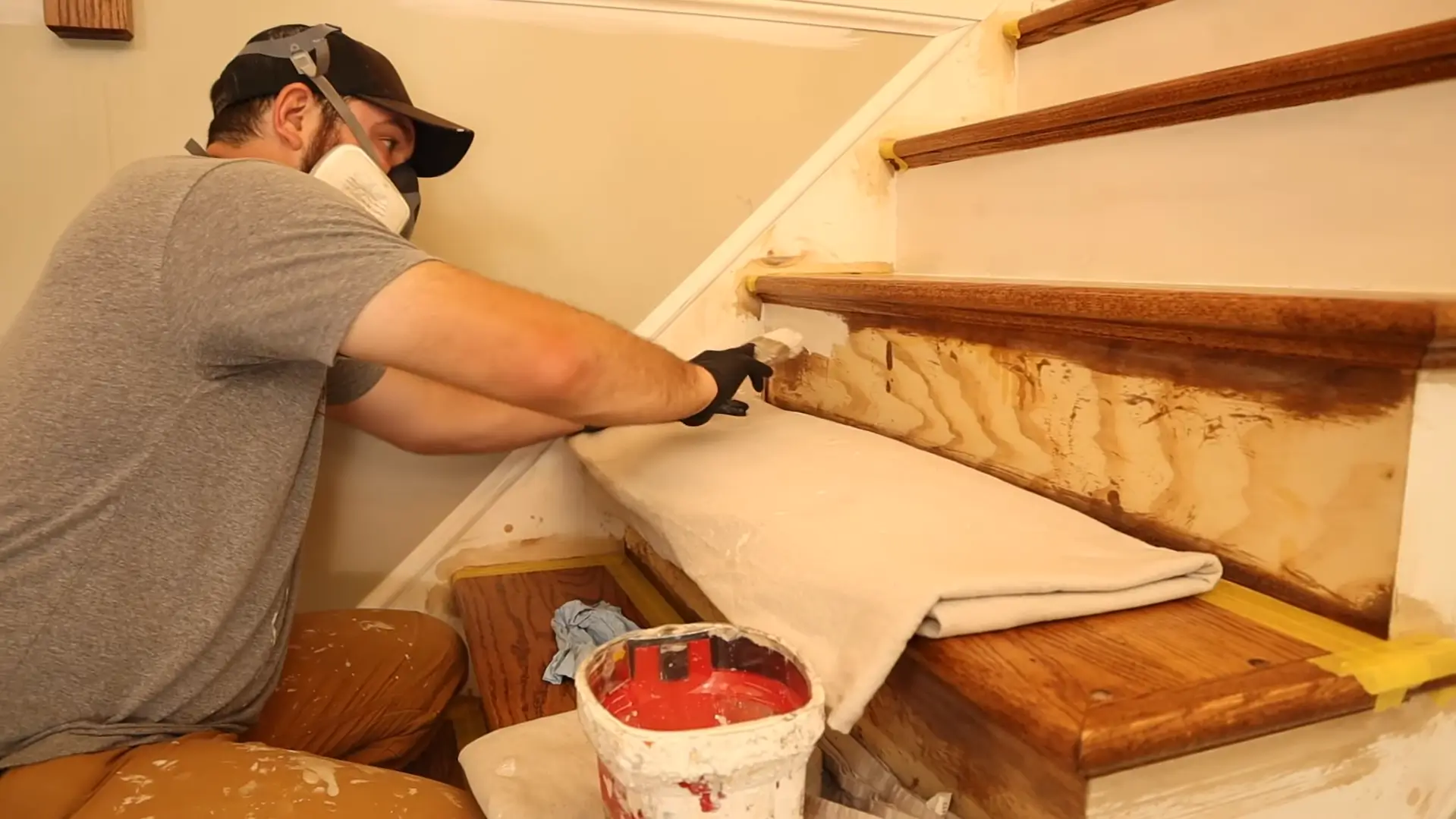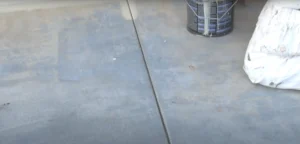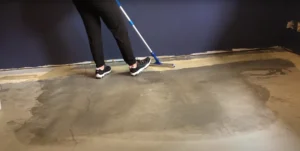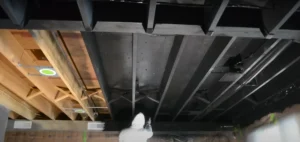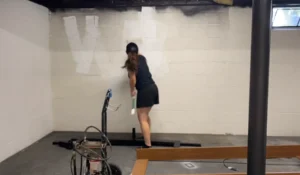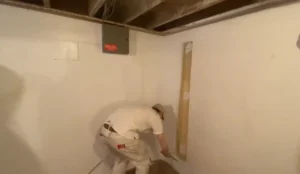Tired of your dull basement stairs? Painting them can give your home a fresh look. Many homeowners struggle with how to paint basement stairs the right way. It’s a task that seems simple but can be tricky without the right know-how.
Did you know that using the wrong paint can lead to peeling and chipping in just a few months? This blog post will guide you through expert tips for painting basement stairs. We’ll cover everything from picking the best paint to applying it correctly.
Get ready to transform your stairs with ease!
Key Takeaways
- Choose satin or semi-gloss paints for durability and easy cleaning on basement stairs.
- Prep stairs by cleaning, sanding, and filling gaps before painting for better adhesion.
- Use a 2.5″ flat brush for detail work and a 4″ high-density foam roller for larger areas.
- Apply primer before painting and sand lightly between coats for a smoother finish.
- Consider adding a clear sealant over the paint for extra protection on high-traffic stairs.
Choosing the Right Paint for Basement Stairs
Picking the right paint for basement stairs is key to a lasting finish. You need a tough, durable paint that can handle foot traffic and moisture.
Best types of paint for durability and coverage
Choosing the right paint for basement stairs is key to a long-lasting finish. Satin or semi-gloss paints offer great durability and easy cleaning. These finishes stand up well to foot traffic and resist scuffs and marks.
For wooden stairs, oil-based paints provide excellent coverage and stick better to the surface.
Floor paints made for high-traffic areas work best on basement stairs. These paints are tough and can handle daily use without chipping or peeling. Avoid cheap paints as they won’t last and may need frequent touch-ups.
Quality paints from trusted brands like Sherwin-Williams or Rust-Oleum are worth the extra cost for their superior coverage and wear resistance.
Preparing Your Stairs for Painting
Prep your stairs for a fresh coat by cleaning and sanding them well. Read on for expert tips to make your basement stairs shine!
Steps to properly clean and sand the stair surfaces
Preparing basement stairs for painting is a key step in the makeover process. Clean and smooth surfaces ensure better paint adhesion and a more polished final look. Here’s how to properly clean and sand your basement stairs:
- Remove debris: Sweep or vacuum the stairs to get rid of loose dirt and dust.
- Wash thoroughly: Use warm, soapy water and a damp cloth to clean each step. Pay extra attention to corners and edges.
- Rinse well: Wipe down the stairs with clean water to remove any soap residue before you paint the top.
- Dry completely: Allow the stairs to air dry fully before moving on to sanding.
- Sand the surfaces: Use medium-grit sandpaper to rough up the existing finish. This helps the new paint stick better.
- Remove loose paint: If there’s old paint, sand off any loose or peeling areas.
- Smooth out rough spots: Focus on any uneven areas or splinters in wooden stairs, particularly on the stair tread.
- Wipe away dust: Use a tack cloth to remove all sanding dust from the stairs.
- Apply painter’s tape: Protect areas you don’t want to be painted, like the handrail or walls.
- Fill gaps or holes: Use wood filler for any cracks or holes in wooden stairs.
- Final inspection: Check that all surfaces are clean, dry, and smooth before painting.
Step-by-Step Painting Techniques
Painting basement stairs needs careful planning, especially when deciding on the paint color. Our step-by-step guide shows you how to get a smooth finish using brushes and rollers.
Tips on using brushes and rollers for a smooth finish
Brushes and rollers are key tools for painting basement stairs. Here are some expert tips to help you achieve a smooth finish:
- Choose the right brush: Use a 2.5″ flat brush for detail work on stairs. This size allows for precise application in tight spots.
- Select a quality roller: Pick a 4″ high-density foam roller for larger areas. This type of roller helps spread paint evenly on stair surfaces.
- Saturate your roller: Make sure the roller is fully soaked with paint. This ensures even coverage and reduces the need for multiple coats.
- Apply primer: Use a primer before painting to create an even base. This step helps the paint adhere better and last longer.
- Sand between coats: Lightly sand the surface after each coat dries to ensure a smooth finish on the stair tread. This creates a smoother finish and helps the next coat stick better.
- Follow a tutorial: Look up a step-by-step guide for painting basement stairs. This can provide helpful visuals and extra tips for your project.
- Use proper technique: Apply paint in long, smooth strokes. This helps avoid brush marks and creates a more professional look.
- Allow drying time: Let each coat dry fully before adding another for the best results on your wood stairs. This prevents smudging and ensures a durable finish.
- Clean tools properly: Wash brushes and rollers thoroughly after use. This keeps them in good shape for future projects.
- Consider a top coat: Apply a clear sealant over the paint for added protection. This is especially useful for high-traffic stairs.
How to Paint Basement Walls (Complementary Tips for Basement Finishing)
Painting basement walls can transform your space and protect against moisture. Here are key steps to paint your basement walls for a fresh look and added durability.
- Check walls for damage: Look for cracks, peeling paint, and moisture issues.
- Fix problems: Remove efflorescence and fill cracks before painting.
- Clean surfaces: Use a mild detergent solution to wash walls thoroughly.
- Apply primer: Use a high-quality, moisture-resistant primer for better paint adhesion.
- Choose the right paint: Pick moisture-resistant and mold-resistant paints for basement walls.
- Ensure good airflow: Open windows or use fans for proper ventilation while painting.
- Wear safety gear: Put on gloves, goggles, and a mask to protect yourself from fumes.
- Paint in sections: Work in small areas to keep a wet edge and avoid lap marks.
- Use the right tools: Rollers work well for large areas, while brushes are best for edges and corners.
- Apply multiple coats: Two coats of paint will give better coverage and protection.
- Allow drying time: Wait at least 24 hours between coats for the best results.
- Touch up as needed: After the paint dries, fix any missed spots or thin areas.
Conclusion
Painting basement stairs can transform your home’s look and feel. With the right tools and methods, you can create an impressive staircase. Proper preparation, selecting durable trim paint, and incorporating slip-resistant features for safety are essential steps in your renovation.
Take your time and follow each step carefully. Your newly painted stairs will bring fresh life to your basement and home, especially if you choose a bold paint color.
FAQs
1. What’s the best way to start painting basement stairs?
Begin by cleaning the stairs. Remove dirt and grime. Next, sand rough spots. Apply a base coat of paint to the treads and risers. Use a roller for large areas and a brush for edges. Let the first coat dry fully before adding another.
2. How long should I wait between coats when painting basement stairs?
Wait at least 24 hours between coats to achieve a smooth finish on your basement stairs. This allows the paint to dry completely. The dry time may vary based on the type of paint and humidity. Check if the paint is dry to the touch before adding another layer.
3. Can I paint wood basement stairs?
Yes, you can paint wood basement stairs. Clean and sand the wood first. Use a primer made for wood surfaces. Then apply floor enamel or porch paint. These paints stand up to wear and tear better than wall paint.
4. What color should I choose for my basement stairs?
Pick a color that fits your basement design. Black painted stairs look modern. Light colors can make the space feel bigger. Consider painting the risers a different color than the treads for a unique look. Test paint samples before deciding.
5. How do I paint stairs while still being able to use them?
Paint every other step. This way, you can still use the stairs while the paint is drying. Once the first set is dry, paint the remaining stairs with your chosen paint color. Another option is to paint the risers first, then the treads. This two-step process lets you use the stairs during the project.
6. What tools do I need to paint the basement stairs?
You’ll need paintbrushes, rollers, sandpaper, and cleaning supplies. Get a putty knife to fill gaps. Buy paint suitable for high-traffic areas from a hardware store. Don’t forget painter’s tape and drop cloths to protect surfaces. A small brush helps with detailed work on the stair edges.

